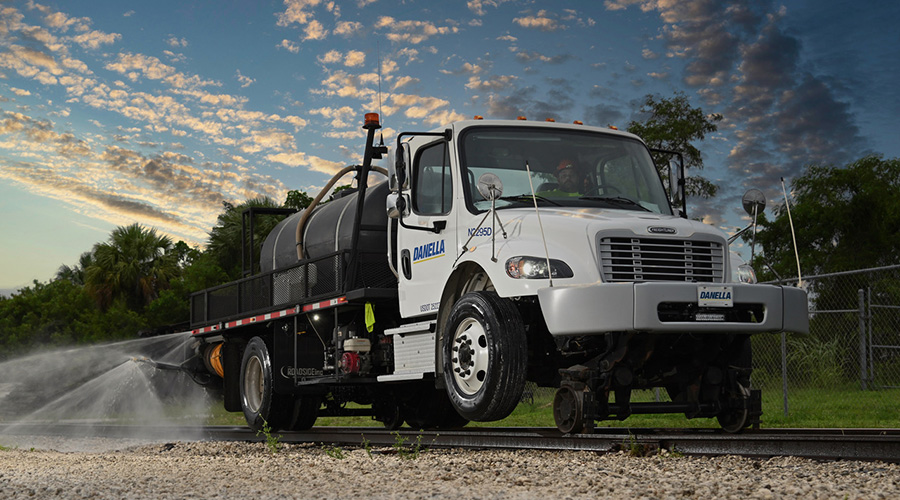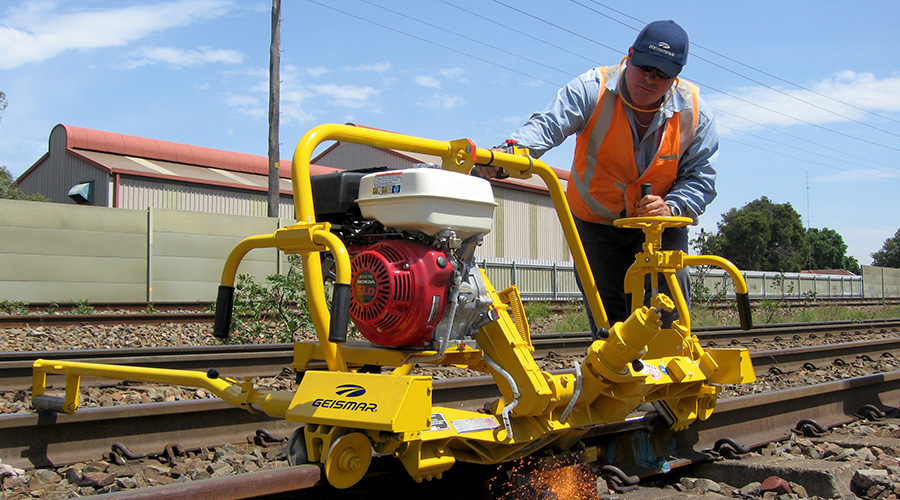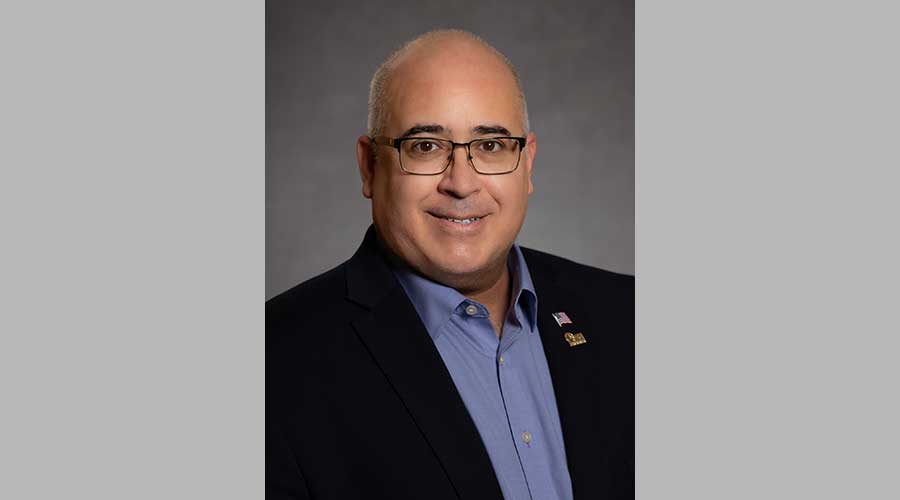Stay updated on news, articles and information for the rail industry
February 2012
Rail News: MOW
Maintenance of way: Vegetation management/weed control
by Walter Weart
Weeds can foul ballast and create drainage problems, while trees and shrubs can encroach on a right of way or hinder sight lines at a grade crossing. Keeping that pesky vegetation in check is a primary maintenance-of-way (MOW) goal for railroads, as well as the contractors and equipment suppliers they turn to for help.
Lately, railroads are outsourcing more brush-cutting work as they redirect their crews to other MOW tasks, says Gerry Blase, manager of spray operations for contractor Asplundh Tree Expert Co., which provides brush-cutting and spraying services in the United States, Canada and Mexico.
Asplundh provides weed-control services with hi-rail vehicles and a spray train, which in summer 2011 treated vegetation along more than 1,500 miles of Canadian Pacific's track. Hi-rail vehicles are limited in range due to tank sizes and are ideal for branch lines and yard work, while spray trains can treat vegetation along more track miles per day, says Blase.
"Even though we have the spray train, we are shifting to hi-rail vehicles for the flexibility they provide," he says.
The company also is using ounces instead of pounds of herbicides per acre because the cost of the chemicals has risen and a treatment can be tailored to vegetation type, he says.
Coming Into View
Asplundh also has been working with Perceptive Robotics L.L.C., which developed the Chlorovision™ Real-Time Spray Control system in 2010. Asplundh plans to deploy the system in summer.
Chlorovision, which uses proprietary vegetation detection algorithms to detect every weed regardless of size, features a spray system designed to cover a 24-foot-wide area with nine independently controlled zones.
"It not only enables more precision spraying, but the system can work both night and day, and at speeds up to 30 miles per hour," says Blase.
Chlorovision also generates high-resolution overhead-view images of a track so defects, such as a broken tie, can be flagged by a spray crew.
"Perceptive Robotics is developing an enhancement to the Chlorovision system to make monitoring visibility conditions at crossings easier and more cost-effective," says Blase.
To provide more optimal vegetation-control services, DeAngelo Brothers Inc. (DBI) is relying on educational efforts with railroads and herbicide advances.
The company provides weed-control and brush-cutting services for freight and passenger railroads, and selective vegetation control services to improve motorists' sight lines at crossings for three Class Is.
"We concentrate on education not only with regulations from agencies, such as the EPA, but also how to best apply the chemicals for the most effective results," says Wayne Hug, vice president of DBI's railroad division.
Chemical Reaction
New and highly effective chemicals are being introduced, such as Perspective® from DuPont and Esplanade™ from Bayer Environmental Science, he says. DBI's research staff works with professors from various universities to test herbicide combinations and rates, especially for difficult-to-control and herbicide-resistant grass and weed species.
Patents on many herbicides began expiring more than 10 years ago and generic products have played a much larger role since then, says Hug.
"When the generics came into the market, the price dropped, but as generics were more heavily used over the years, control of many species became more difficult and herbicide resistance increased," he says. "Now, our market is at a point where more substantial investment into maintenance budgets is required to use some of the new products that are required to deliver the level of control that all railroads require."
Another way to improve vegetation management: coordinate efforts with a railroad's operations staff, says Hug. Over the past two years, DBI's work in UP's Los Angeles Service Unit has included more planning and cooperation with local transportation department personnel to coordinate applications around train schedules.
"When we saw that we had a 12-hour window on a Saturday, we put three units in service to accomplish as much as possible during that timeframe," says Hug.
For All Railroad Services Corp. (ARS), coordinating vegetation-control processes is key.
"One of the techniques we are advocating is to cut and spray at the same time, as this does a much better job of controlling new growth," says Vinnie Vaccarello, co-president of ARS, which provides weed and brush-control, and crossing vegetation cutting and maintenance services. "We know that our customers have placed a high value on track time, so we seek new ways to be more efficient."
The company also provides pole-line removal services, "and we are advocating brush cutting at the same time to better unitize time and equipment," says Vaccarello.
Meanwhile, Mercier's Inc. continues to adopt new technologies for its spray trucks and equipment to better control vegetation, says President and Chief Executive Officer Craig Mercier.
The company, which offers vegetation management services to North American railroads, has been using GPS, mapping and variable rate controllers for more than three years to help control customers' costs and provide guaranteed results, says Mercier. The company is evaluating other hardware enhancements and software upgrades for the trucks.
Railroads also are seeking pre-emergent herbicide programs that offer broad-spectrum control of broadleaf weeds and grasses. However, it's challenging to determine an optimal spray application window due to timing, weather, wind and the targeted weed species, says Mercier.
The company is developing, testing and evaluating a proprietary application system designed to regulate a precise herbicide blend for a problematic weed or brush species — such as kochia, marestail, poison hemlock, Russian thistle, honeysuckle, wild rose and poison oak — and specific geographic areas.
To be developed by year's end or in early 2013, the system is designed to use an ultra-high-speed, high-definition camera that sends a weed's image to a computer. A computer program then would identify and adjust the application mix to address the identified plant. The system produces a report that tracks a host of essential elements for a successful application, says Mercier.
Keeping The Upgrades Coming
Boatright Vegetation Management also aims to upgrade its equipment continually, such as with new onboard computers, all-electric switches and digital controls, says Shane Boatright, president of parent Boatright Cos. Inc.
Boatright Vegetation Management is noting more of a trend toward one-man vehicles and tote systems. A large vat of chemical weighing 3,200 pounds is loaded onto a truck by forklift, providing an effective means for one-man operations, says Boatright. The company offers a one-man operation featuring a 400-gallon tote.
For Nordco Inc., helping contractors and railroads enhance vegetation-management performance prompted a redesign last year of its model BC 60 brush cutter, including revamped electrical and hydraulics systems, a new fully enclosed cab and more ergonomic controls.
In addition, the brush cutter features a diesel engine that's compliant with the U.S. Environmental Protection Agency's Tier 3 emission standard, says Bill Straub, president of Nordco's equipment services business unit.
Wanted: Better Brush Cutter
RBL Inc./Robolube also is attempting to improve the performance of its brush cutter, the Tiger RailKut®, which is hi-rail mounted. Available since 2005, the cutter comprises a Ford F-550 truck with a 21-foot-reach boom-type mower designed to cut trees up to six inches in diameter.
Railroads are seeking a larger truck with the capability to cut brush 28 to 30 feet from a track's centerline, said RBL/Robolube President Robert Pieper in an email. The company is evaluating that concept while trying to maintain the Tiger RailKut's stability and ease of rail access/deployment, he said, adding that the enhancement would increase the cutter's cost because of larger rail gear, chassis and booms.
"If we determine that this is feasible from an operational and safety standpoint, the next step would be querying the railroads for their perception of accepting the higher cost to achieve these desired results," said Pieper.
Since 2008, RBL/Robolube also has offered the Tiger WetCut™, which is designed to apply herbicide directly after a cut. The system can be used for spot spraying or continuous operation, and with rotary or flail cutters.
RailWorks Corp. also offers vegetation control services with a Tiger RailKut, which can be used as a mower or flail cutter. The company provides the services to Class Is, including CN and CP, as well as OmniTRAX Inc., RailAmerica Inc. and industrial clients.
"We have two RailKut units and have been offering this service for the past four years," says Jim Hansen, RailWorks' vice president of business development-track.
Making The Cut
Brandt Road Rail Inc., which provides brush-cutting attachments for its Brandt Rail Tool, has offered cutting services for a shorter time. Last year, the company formed Brandt Rail Services to offer customers its MOW equipment via a service plan, said Vice President of Rail Services Steve Orrell in an email.
Provided as weekly or monthly packages, the services include a self-powered excavator package for the Brandt Rail Tool, which comes equipped with a 52-inch brush-cutting head that's powered by a dedicated power source to prevent the loss of motive or braking power. If heavy brush, refuse or timber products need to be removed from the same remote sight, the Brandt Rail Tool can pull up to two air dumps or gondolas to haul away all types of material, said Orrell.
CP has used the Brandt Rail Tool via Brandt Rail Services, and BNSF Railway Co. and KCS have used Brandt Power Units via the services division.
Brandt Road Rail also continues to sell the Brandt Rail Tool to railroads. For example, CSXT owns and operates seven of the machines for brush-cutting operations, said Orrell.
Walter Weart is a Denver-based free-lance writer. Email questions to prograil@tradepress.com.


 2025 MOW Spending Report: Passenger-rail programs
2025 MOW Spending Report: Passenger-rail programs
 Gardner steps down as Amtrak CEO
Gardner steps down as Amtrak CEO
 Guest comment: Oliver Wyman’s David Hunt
Guest comment: Oliver Wyman’s David Hunt
 Women of Influence in Rail eBook
Women of Influence in Rail eBook
 railPrime
railPrime







